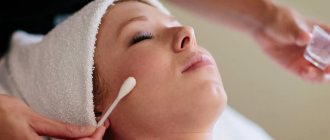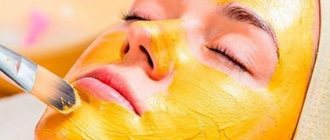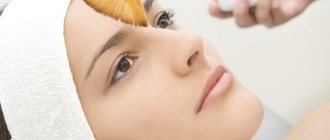What is the difference: home peeling and peeling at a cosmetologist
Peels that can be used at home do not penetrate deeply into the skin and give an unnoticeable result, but they certainly help maintain an even tone and healthy skin. Chemical peels performed by estheticians have a lower pH level than at-home peels, so they can penetrate much deeper into the skin and target skin problems such as hyperpigmentation and acne. Chemical peels can cause redness of the skin; a recovery period will last for several days, during which the “old” skin will gradually peel off and renewed skin will appear.
Chemical peeling performed by cosmetologists will be much more effective for your skin than peeling at home.
Types of chemical skin peeling
Superficial peeling is the most gentle and safe way to refresh and rejuvenate the face, neck and décolleté. The impact is only on the thin stratum corneum of the epidermis (the outermost layer of the skin), so side effects from this procedure are practically eliminated (subject to all rules of post-peel care). When talking about superficial peeling, the expression “weekend peeling” is often used, since rehabilitation takes approximately the same period of time as a weekend.
The method helps improve the color and structure of the skin, is effective in combating acne and seborrhea, but does not guarantee getting rid of deep wrinkles, unevenness, and large age spots. Typically, patients under 40 years of age resort to this procedure to correct minor problems.
Depending on the condition and needs of the skin, lactic and fruit acids (AHA), salicylic acid, glycolic acid or 10-15% trichloroacetic acid are used for superficial peels. Instead of acids, enzymes can be used (enzyme peeling or enzymatic peeling). All these compositions, in addition to exfoliating dead cells, are designed to solve different problems (regulating hydrobalance, reducing pores, increasing tone, reducing inflammation, lightening, etc.), therefore, a cosmetologist can determine which active ingredient is preferable for the patient only after a face-to-face meeting .
Very popular in recent years, retinoic peeling or yellow peeling (active ingredients - retinol, retinoic acid) also belongs to superficial peelings in terms of the type of action on the skin, but is closer in effectiveness to medium peelings.
Retinoic peeling (retinol cleansing) is the choice, for example, when working with mature and/or pigmented skin, as well as skin prone to rashes.
Superficial peelings are usually carried out in courses of 4-6 procedures with a frequency of no more than once a week.
Medium peeling - its effect extends to the entire structure of the epidermis to the basement membrane. This is a very effective procedure, but the patient should be prepared for unpleasant sensations - with medium peeling, the concentration of acids is higher than with superficial manipulations, so the degree of skin damage is greater. The procedure involves further rehabilitation at home for about 7-10 days (due to severe redness and flaking of the skin).
Medium peels usually include trichloroacetic acid (or TCA) at a concentration of 30-40%, salicylic acid, and Jessner's solutions. By exfoliating dead skin cells of the epidermis, these components penetrate into the deep layers of the skin, causing the activity of living dermal cells. The procedure helps restore the protective properties of the skin, improve its turgor, increase density and elasticity. After medium peeling, manifestations of sagging skin go away, wrinkles straighten, scar elements, stretch marks, and age spots are smoothed out.
The procedure is carried out exclusively in the autumn-winter period, since renewed skin becomes especially susceptible to sunlight, and this threatens hyperpigmentation. The recommended course is from five sessions.
Deep peeling is the most impressive in action, but also the most traumatic. This is a serious chemical burn that damages the skin to the point of “blood dew.” This procedure is carried out under anesthesia and only in a hospital setting. The rehabilitation period after deep peeling can take months, but the effect will last for several years.
This procedure is also called phenol peeling because it is performed using phenol (carbolic acid). Under the influence of this substance, the entire stratum corneum of the skin is burned, and with it wrinkles, scars, signs of sagging and sagging skin. The density and elasticity of the epidermis is renewed and restored, and the structure of the dermis is rejuvenated.
Indications for such peeling may include age from 60 years or the presence of significant skin defects.
There is no need to talk about deep peeling as a course procedure because of its high traumatic and painful nature. A repeat is possible no earlier than in a few years.
Since chemical peeling is a radical method, the procedure must be carried out by a highly qualified dermatocosmetologist in a specially equipped medical office!
Indications for chemical peeling:
- biological aging;
- small superficial wrinkles;
- enlarged pores;
- freckles;
- dark spots;
- acne, post-acne;
- melasma;
- lentigo;
- stretch marks (stretch marks);
- sagging skin.
Contraindications to chemical peeling
- cancer;
- poor wound healing;
- tendency to form scars;
- pronounced rosacea;
- infectious diseases;
- dermatological diseases;
- chronic diseases in the acute stage;
- pregnancy and lactation;
- tan, very dark skin;
- recent invasive cosmetic procedures;
- taking certain medications.
1 Superficial chemical peeling procedure
2 Applying regenerating cream
3 Applying regenerating cream
Contraindications:
- The procedure is not recommended for pregnant and lactating women;
- When taking medications based on isotretinoin;
- For herpes and skin diseases;
- When taking antibiotics;
- For oncological diseases;
- For open wounds.
After a chemical peel, the skin is more sensitive to sunlight, so after the procedure it is necessary to use sunscreens and products.
Before the procedure, the cosmetologist must take into account many factors and ask all the necessary questions so that the procedure is as comfortable as possible for the client and gives the best result with the fewest possible side effects.
Peeling (3 stages)
It is better to entrust this procedure to specialists, as this is quite a serious manipulation. The effect after deep peeling is truly amazing, as proven by the before and after photos - the skin becomes healthier, becomes younger, regeneration processes are accelerated, wrinkles and defects disappear.
It is worth noting that the procedure has contraindications and age restrictions, which will be described below, so before carrying out a consultation with a cosmetologist will be required!
It’s worth saying right away that not every woman can withstand deep chemical peeling, because it is a rather unpleasant and lengthy procedure that lasts at least 45 minutes (sometimes two hours). During this manipulation, the facial skin is “burned out”, so the client may experience very painful and uncomfortable sensations. It is possible to initially conduct the session under general anesthesia, otherwise the patient is sedated with strong painkillers. For the safety of the patient, the patient must be connected to a cardiac monitor in the salon and an anesthesiologist must be present in the room.
If these services are not available for your deep chemical peel, consider finding another location for the procedure.
The session is carried out in several stages:
- Cleansing the skin with aggressive soap and a sponge, followed by alcohol degreasing.
- Now the phenol-based peeling mixture itself is applied. It is smeared onto individual areas of the skin, and then distributed evenly using a special device. This is done because the skin in different areas has a different structure, so it is important to observe the proportions of application of the drug.
- The skin is treated with medications that contain antibiotics, and they are also prescribed for oral administration.
Deep chemical peeling of the face is done no more than once a year. The frequency will depend on the condition of the skin and the patient himself, as well as on the doctor’s recommendations. Some doctors generally advise going for such manipulation only a couple of times in your entire life.
How is peeling performed and what should you pay attention to after the procedure?
Before the procedure, the skin is cleansed and “degreased”. During the procedure, you will feel warmth and burning on the treated skin surface. To reduce discomfort, you can use a fan or local anesthetic. After peeling, first of all, take care of protecting your skin from the sun, so it is not recommended to carry out the procedure at the height of summer or before leaving for warm countries.
After peeling, you will feel tightness and slight dryness of the skin. The skin may remain red for an hour after the procedure. The condition of the skin in the post-peeling period depends on the type of skin and the type of peeling performed.
It is recommended to avoid excessive physical activity and excessive sweating for several days after the procedure. Do not rub the treated skin area after peeling. Do not use retinol or AXA products for at least 10 days after peeling. Avoid visiting the sauna or bathhouse for several days.
Is it worth peeling, and if so, what kind?
20.02.2021
For the sake of beauty, a woman is ready to do anything, even remove the top layer of skin. It sounds terrible, but it's actually just the result of a procedure called exfoliation.
How it works?
Due to the effects on the skin (which will be described below), the body tries to heal itself by producing the most useful substances for restoration, such as elastin and collagen. In other words, the thin top layer is removed, and a new one is formed in its place. All this is thanks to the great gift of nature - regeneration. After this procedure, the skin becomes soft, silky, wrinkles are smoothed out, the woman looks younger and happier.
There are three types of peeling .
Mechanical peeling
It involves the use of very fine solid particles that undermine dead skin particles, thereby very effectively cleansing it. This is an affordable and convenient option for those who prefer to independently care for their face and body skin at home.
Chemical peeling
Based on the use of acid or other chemical substance. Unlike mechanical peeling , chemical peeling penetrates deeper into the skin. The substance used dissolves the top layer and moves on, which is why a distinction is made between medium and deep peeling . The second is used only as a last resort and only on mature skin. Of course, there is no escape from unpleasant sensations, but thanks to the high level of modern cosmetology , there will definitely be no consequences that would upset the client.
Laser peeling
The main feature is that it is not necessary to injure the entire skin if you need to remove a small wrinkle, stretch marks or even a scar. All this is possible thanks to adjustable peeling . The bottom line is that dead skin particles are removed after the skin cells are rid of moisture. This is one of the most painless and effective peeling .
So, why should you try peeling?
- The skin becomes smooth and elastic.
- The skin breathes because all the old unnecessary particles and dirt that cannot be gotten rid of at home have been removed from it. As a result, the cells will remain youthful longer.
- Thanks to peeling, you can get rid of scars, age spots, and stretch marks.
- One of the most important advantages is the ability to remove, at least partially, rough wrinkles that make women look older.
- If your skin is oily, peeling will help make it more matte and also tighten pores.
- If you cleanse your skin regularly, you can prevent the rapid appearance of wrinkles.
- After peeling, the skin is more pliable for using various creams and masks.
Be that as it may, after a cosmetic procedure, a woman not only looks, but also feels younger, and the psychological mood, as we know, is very important.
Do not forget about contraindications, for example, pregnancy and lactation, some diseases do not allow the use of chemicals. It is better to check the full list of prohibitions in the salon where the procedure will be performed.
Published in Cosmetology Premium Clinic
Result after peeling
The procedure can give truly stunning effects. It is most often carried out for the following purposes:
- improved blood circulation;
- regulation of the sebaceous glands on the face;
- removing dead cells that clog pores;
- lifting, elastin production;
- natural regeneration;
- rejuvenation;
- smoothing wrinkles and scars;
- getting rid of pigmentation.
Before deciding on exfoliation, the patient is recommended not only to consult a doctor, but also to undergo an examination in order to prevent all possible negative consequences. It is also important to trust good professionals, and not beginners in this matter.










